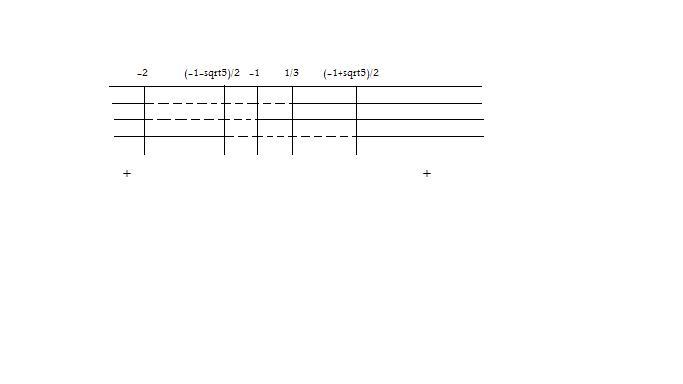[math]\begin{cases} 3x^2+5x>2 \\ 1/3x^2+x+2/3>0 \\ x^2+x-1>0 \ \end{cases}[/math]
[math]\begin{cases} 3x^2+5x>2 \\ 1/3x^2+x+2/3>0 \\ x^2+x-1>0 \ \end{cases}[/math]
;
[math]\begin{cases} 3x^2+5x-2>0 \\ x^2+3x+2>0 \\ x^2+x-1>0 \ \end{cases}[/math]
;
Studiamo le tre
disequazioni singolarmente
1)
[math]3x^2+5x-2>0[/math]
[math]Delta=b^2-4ac=(5)^2-(4 \cdot (-2) \cdot 3)=25+24=49[/math]
[math]x_(1,2)=(-b+-\sqrt{Delta})/(2a)=(-5+-\sqrt(49))/6=(-5+-7)/6 => x_1=-2 ^^ x_2=1/3[/math]
.
Siccome il coefficiente di
[math]x^2[/math]
e il segno della disequazione sono concordi,
prenderemo come soluzione accettabile l'intervallo esterno, per cui la soluzione sarà:
[math]x>-2 vv x>1/3[/math]
.
2)
[math]x^2+3x+2>0[/math]
[math]Delta=b^2-4ac=(3)^2-(4 \cdot 2 \cdot 1)=9-8=1[/math]
[math]x_(1,2)=(-b+-\sqrt{Delta})/(2a)=(-3+-\sqrt1)/2=(-3+-1)/2 => x_1=-1 ^^ x_2=-2[/math]
.
Siccome il coefficiente di
[math]x^2[/math]
e il segno della disequazione sono concordi,
prenderemo come soluzione accettabile l'intervallo esterno, per cui la soluzione sarà:
[math]x>-2 vv x> -1[/math]
.
3)
[math]x^2+x-1>0[/math]
[math]Delta=b^2-4ac=(1)^2-(4 \cdot 1 \cdot (-1))=1+4=5[/math]
[math]x_(1,2)=(-b+-\sqrt{Delta})/(2a)=(-1+-\sqrt5)/2=(-1+-\sqrt5)/2 => x_1=(-1+\sqrt5)/2 ^^ x_2=(-1-\sqrt5)/2[/math]
.
Siccome il coefficiente di
[math]x^2[/math]
e il segno della disequazione sono concordi,
prenderemo come soluzione accettabile l'intervallo esterno, per cui la soluzione sarà:
[math]x>(-1-\sqrt5)/2 vv x>{-1+\sqrt5}/2[/math]
Pertanto
[math]\begin{cases} x>-2 vv x>1/3 \\ x>-2 vv x>-1 \\ x>(-1-\sqrt5)/2vv x>{-1+\sqrt5}/2 \ \end{cases}[/math]
;
Soluzione del sistema sarà l'intersezione delle singole soluzioni delle disequazioni che lo compongono.

Quindi la soluzione sarà:
[math]x>-2vv x>(-1+\sqrt5)/2[/math]
.








 Accedi a tutti gli appunti
Accedi a tutti gli appunti
 Tutor AI: studia meglio e in meno tempo
Tutor AI: studia meglio e in meno tempo